Boron Deficiency
Problem: Cannabis leaves and roots show abnormal and slowed growth when showing a boron defiency. The first signs of a cannabis boron deficiency is abnormal or thick growth tips. New leaves may display chlorosis (yellowing of leaves). Stems may become rough or hollow. The plant may look like it has a calcium deficiency because boron is needed for the plant to properly use calcium. New growth is affected the most, and may look like it's been burnt or scorched.
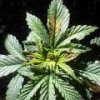
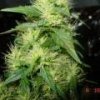
Solution: Boron is not absorbed will without enough potassium and nitrogen, or if there isn't enough moisture. You plant may also exhibit signs of a boron deficiency if the pH is too high or low. Flush your system with clean, pH'd water that contains about half the nutrients needed for the plant and watch to make sure that the problem clears up for new growth.
Calcium Deficiency
Problem: Signs of a cannabis calcium deficiency can be hard to pin down since calcium deficiencies are often accompanied by magnesium, iron, and other deficiencies. However, some of the major signs of a calcium deficiency are in the leaves which will display dead spots, crinkling, spotting, or small brown spots. Another sign of a cannabis calcium deficiency is new leaves will appear small and distorted with curled tips The insides of the plant and well as the flowers/buds may show signs of decay. Roots may show signs of bacteria and may be dying off or be under developed.

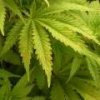
Solution: If the pH of your root zone is off, then your cannabis cannot properly absorb calcium through its roots so the first step is to ensure that you have the correct pH for your growth medium. Different strains of cannabis tend to have different nutrient problems, but calcium, magnesium, and iron deficiencies often appear together in cannabis. Therefore many growers decide to purchase some sort of Calcium-Magnesium (often called Cal-Mag) supplement for their grow room in case this common deficiency appears. I have listed some available Cal-Mag supplements that I have used along below with some general information about each one. After supplementing with Cal-Mag and correcting the pH, you should expect to see new healthy growth within a week.
Copper Deficiency
Problem: A cannabis copper deficiency manifests itself as leaves curling back, lack of growth, and unusual coloring of the leaves. New young leaves may be dark and twisted, while other leaves may start showing signs of yellow or white. It is very unlikely that there is no copper available in your water or soil. Copper deficiencies generally crop up when there is a pH problem, so that the cannabis can't get to the copper even though it's there.


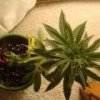
Solution: Flush your system with clean, pH'd water that contains about half the correct amount of nutrients needed by the plant. Watch to make sure that the problem starts to clear up within a couple of days.
Heat and Light Stress
Problem: Your cannabis plant can only withstand a certain amount of heat and light. After a certain point, your cannabis will start exhibiting signs of stress on the leaves near the sources of light and/or heat. Your leaves will get yellow or brown brown spotting and may appear generally burnt in places. The first two pictures are of heat stress, and the last picture shows a marijuana plant which is showing signs of light burn (too much light).


Solution: Find a way to lower the temperature and/or increase the circulation in the grow room or grow area if heat is the problem. If your marijuana plants are just getting too much light, try removing some of the lights or moving your lights further away from the tops of the plants. When learning how to weed, it's best to try to keep things at a comfortable room temperature at all times for optimal growth.
Iron Deficiency
Problem: An iron deficiency manifests itself as yellowing of the leaves although the veins will tend to stay green. It looks similar to a magnesium deficiency, but will only affect younger leaves.


Solution: Iron deficiencies are very uncommon as long as the pH is kept below 6.5 (5.7 for hydroponic or rockwool). Too much Phosphorus can also lock up iron. The best thing you can do is check the pH of your system, and then flush the system with clean pH'd water that contains nutrients at half strength to start, then start working your way up to full nutrient strength. It's worthwhile to note that iron has a tendency to react with many other components of fertilizer solutions and can cause other nutrients to be locked up from the plant. When supplementing your plant with iron, it is often necessary to not use fertilizer for that watering. If you are supplementing with iron, make sure you first read the label of both the fertilizer and the iron supplement you are using to minimize any problems.
Magnesium Deficiency
Problem: The edges of the leaves may become yellow or bright green and may start feeling crispy to the touch. The light green or yellow coloring may also effect the veins of the leaves.

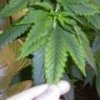
Solution: It is very important to maintain a proper pH in order to avoid a magnesium deficiency. Adding more magnesium to a system when there is a pH lock-out will only make the situation worse because the plant will not be able to absorb any magnesium until the pH has been corrected. Flush the system with properly pH'ed water that contains a full set of proper nutrients and see if the new growth starts looking healthier.
Manganese Deficiency
Problem: Leaves may become yellow in between the veins, with mottled brown spots on the affected leaves. These brown dead patches may spread and eventually kill the leaf. Leaves may also shred and fall apart.
Overall growth of the marijuana plant may be stunted.

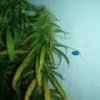
Solution: Manganese deficiencies are often caused by a pH that is too high, or if the plant is getting too much iron.
If you have a manganese deficiency in soil, try to correct pH to 6.0 - 6.5l. In hydro, correct pH to 5.5 - 6.0. You are looking to avoid higher pH ranges, as this is where manganese deficiencies are most likely to occur.
Flush your system with clean, pH'd water that contains about half the correct amount of nutrients needed by the plant. Watch to make sure that the problem starts to clear up within a couple of days.
Molybdenum Deficiency
Problem: The initial symptoms may appear similar to a nitrogen deficiency (yellowing of older, lower leaves). Leaves may become mottled or spotted. However, the tell-tale sign of a molybdenum deficiency is the leaves may start to display a unique orange, red or pink color around the edges which will start to move toward the center of the leaf. Sometimes the color appears in the middle of the leaves as opposed to the edges.

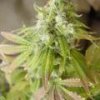
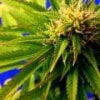
Solution: Flush your system with clean, pH'd water that contains about half the correct amount of nutrients needed by the plant. Watch to make sure that the problem starts to clear up within a couple of days. Molybdenum gets locked out at lower pH ranges. Molybdenum may get locked out in soil that has a pH of lower than 6.5. With hydro or soil-less mediums, molybdenum may be locked out at pH ranges of 5.5-6.0 and lower. Try to keep the pH of your growing medium above these ranges to help prevent a molybdenum deficiency.
Nitrogen Deficiency
Problem: Nitrogen is important during the vegetative stage of your cannabis plants. As your plants start flowering, they will need lower amounts of nitrogen. A nitrogen deficiency will cause the older, lower leaves on your plant to start turning yellow and eventually die. It's relatively normal for your plant's leaves to start turning yellow towards the end of your flowering cycle as the plant becomes nitrogen deficient while it's creating its buds. However, if you notice your leaves turning yellow in the vegetative stage or in the beginning parts of the flowering stage, your plant may be experiencing a nitrogen deficiency which will need to be treated. The first picture is a plant in the vegetative stage which is experiencing the beginnings of a nitrogen deficiency. The second plant is showing signs of nitrogen deficiency late in flowering and is completely normal. The last picture is an infographic about nitrogen and your marijuana plant.


Solution: You can find many pre-mixed nutrients from the store which contain nitrogen or you could use nitrate of soda or organic fertilizer which are both good sources of nitrogen. Try supplementing your regular nutrients with a bit more nitrogen and see if the plant starts recovering.
Hope this Helps everyone with their plant problems.
If the pictures are to small just download them and look at them with a pic viewer on your PC so you can zoom in to them. (sorry about that).
If you find this useful please click the "like" button or "rep" button so I know..and I will keep updating it.
Thank you "bigrake" for this chart, I Think this will be a great addition to this tread.
Please feel free to download this chart and print it off for a quick diagnoses to plant problems.
View attachment 2462203
Problem: Cannabis leaves and roots show abnormal and slowed growth when showing a boron defiency. The first signs of a cannabis boron deficiency is abnormal or thick growth tips. New leaves may display chlorosis (yellowing of leaves). Stems may become rough or hollow. The plant may look like it has a calcium deficiency because boron is needed for the plant to properly use calcium. New growth is affected the most, and may look like it's been burnt or scorched.


Solution: Boron is not absorbed will without enough potassium and nitrogen, or if there isn't enough moisture. You plant may also exhibit signs of a boron deficiency if the pH is too high or low. Flush your system with clean, pH'd water that contains about half the nutrients needed for the plant and watch to make sure that the problem clears up for new growth.
Calcium Deficiency
Problem: Signs of a cannabis calcium deficiency can be hard to pin down since calcium deficiencies are often accompanied by magnesium, iron, and other deficiencies. However, some of the major signs of a calcium deficiency are in the leaves which will display dead spots, crinkling, spotting, or small brown spots. Another sign of a cannabis calcium deficiency is new leaves will appear small and distorted with curled tips The insides of the plant and well as the flowers/buds may show signs of decay. Roots may show signs of bacteria and may be dying off or be under developed.


Solution: If the pH of your root zone is off, then your cannabis cannot properly absorb calcium through its roots so the first step is to ensure that you have the correct pH for your growth medium. Different strains of cannabis tend to have different nutrient problems, but calcium, magnesium, and iron deficiencies often appear together in cannabis. Therefore many growers decide to purchase some sort of Calcium-Magnesium (often called Cal-Mag) supplement for their grow room in case this common deficiency appears. I have listed some available Cal-Mag supplements that I have used along below with some general information about each one. After supplementing with Cal-Mag and correcting the pH, you should expect to see new healthy growth within a week.
Copper Deficiency
Problem: A cannabis copper deficiency manifests itself as leaves curling back, lack of growth, and unusual coloring of the leaves. New young leaves may be dark and twisted, while other leaves may start showing signs of yellow or white. It is very unlikely that there is no copper available in your water or soil. Copper deficiencies generally crop up when there is a pH problem, so that the cannabis can't get to the copper even though it's there.



Solution: Flush your system with clean, pH'd water that contains about half the correct amount of nutrients needed by the plant. Watch to make sure that the problem starts to clear up within a couple of days.
Heat and Light Stress
Problem: Your cannabis plant can only withstand a certain amount of heat and light. After a certain point, your cannabis will start exhibiting signs of stress on the leaves near the sources of light and/or heat. Your leaves will get yellow or brown brown spotting and may appear generally burnt in places. The first two pictures are of heat stress, and the last picture shows a marijuana plant which is showing signs of light burn (too much light).


Solution: Find a way to lower the temperature and/or increase the circulation in the grow room or grow area if heat is the problem. If your marijuana plants are just getting too much light, try removing some of the lights or moving your lights further away from the tops of the plants. When learning how to weed, it's best to try to keep things at a comfortable room temperature at all times for optimal growth.
Iron Deficiency
Problem: An iron deficiency manifests itself as yellowing of the leaves although the veins will tend to stay green. It looks similar to a magnesium deficiency, but will only affect younger leaves.


Solution: Iron deficiencies are very uncommon as long as the pH is kept below 6.5 (5.7 for hydroponic or rockwool). Too much Phosphorus can also lock up iron. The best thing you can do is check the pH of your system, and then flush the system with clean pH'd water that contains nutrients at half strength to start, then start working your way up to full nutrient strength. It's worthwhile to note that iron has a tendency to react with many other components of fertilizer solutions and can cause other nutrients to be locked up from the plant. When supplementing your plant with iron, it is often necessary to not use fertilizer for that watering. If you are supplementing with iron, make sure you first read the label of both the fertilizer and the iron supplement you are using to minimize any problems.
Magnesium Deficiency
Problem: The edges of the leaves may become yellow or bright green and may start feeling crispy to the touch. The light green or yellow coloring may also effect the veins of the leaves.


Solution: It is very important to maintain a proper pH in order to avoid a magnesium deficiency. Adding more magnesium to a system when there is a pH lock-out will only make the situation worse because the plant will not be able to absorb any magnesium until the pH has been corrected. Flush the system with properly pH'ed water that contains a full set of proper nutrients and see if the new growth starts looking healthier.
Manganese Deficiency
Problem: Leaves may become yellow in between the veins, with mottled brown spots on the affected leaves. These brown dead patches may spread and eventually kill the leaf. Leaves may also shred and fall apart.
Overall growth of the marijuana plant may be stunted.


Solution: Manganese deficiencies are often caused by a pH that is too high, or if the plant is getting too much iron.
If you have a manganese deficiency in soil, try to correct pH to 6.0 - 6.5l. In hydro, correct pH to 5.5 - 6.0. You are looking to avoid higher pH ranges, as this is where manganese deficiencies are most likely to occur.
Flush your system with clean, pH'd water that contains about half the correct amount of nutrients needed by the plant. Watch to make sure that the problem starts to clear up within a couple of days.
Molybdenum Deficiency
Problem: The initial symptoms may appear similar to a nitrogen deficiency (yellowing of older, lower leaves). Leaves may become mottled or spotted. However, the tell-tale sign of a molybdenum deficiency is the leaves may start to display a unique orange, red or pink color around the edges which will start to move toward the center of the leaf. Sometimes the color appears in the middle of the leaves as opposed to the edges.



Solution: Flush your system with clean, pH'd water that contains about half the correct amount of nutrients needed by the plant. Watch to make sure that the problem starts to clear up within a couple of days. Molybdenum gets locked out at lower pH ranges. Molybdenum may get locked out in soil that has a pH of lower than 6.5. With hydro or soil-less mediums, molybdenum may be locked out at pH ranges of 5.5-6.0 and lower. Try to keep the pH of your growing medium above these ranges to help prevent a molybdenum deficiency.
Nitrogen Deficiency
Problem: Nitrogen is important during the vegetative stage of your cannabis plants. As your plants start flowering, they will need lower amounts of nitrogen. A nitrogen deficiency will cause the older, lower leaves on your plant to start turning yellow and eventually die. It's relatively normal for your plant's leaves to start turning yellow towards the end of your flowering cycle as the plant becomes nitrogen deficient while it's creating its buds. However, if you notice your leaves turning yellow in the vegetative stage or in the beginning parts of the flowering stage, your plant may be experiencing a nitrogen deficiency which will need to be treated. The first picture is a plant in the vegetative stage which is experiencing the beginnings of a nitrogen deficiency. The second plant is showing signs of nitrogen deficiency late in flowering and is completely normal. The last picture is an infographic about nitrogen and your marijuana plant.


Solution: You can find many pre-mixed nutrients from the store which contain nitrogen or you could use nitrate of soda or organic fertilizer which are both good sources of nitrogen. Try supplementing your regular nutrients with a bit more nitrogen and see if the plant starts recovering.
Hope this Helps everyone with their plant problems.
If the pictures are to small just download them and look at them with a pic viewer on your PC so you can zoom in to them. (sorry about that).
If you find this useful please click the "like" button or "rep" button so I know..and I will keep updating it.
Thank you "bigrake" for this chart, I Think this will be a great addition to this tread.
Please feel free to download this chart and print it off for a quick diagnoses to plant problems.
View attachment 2462203
